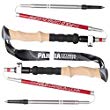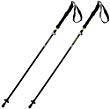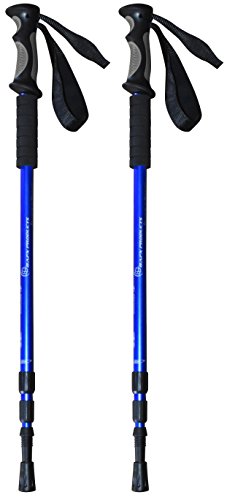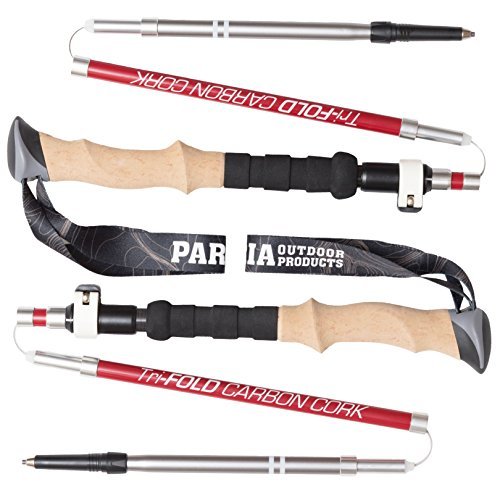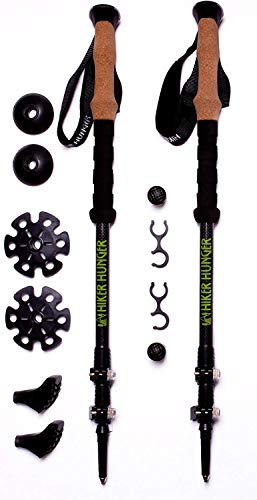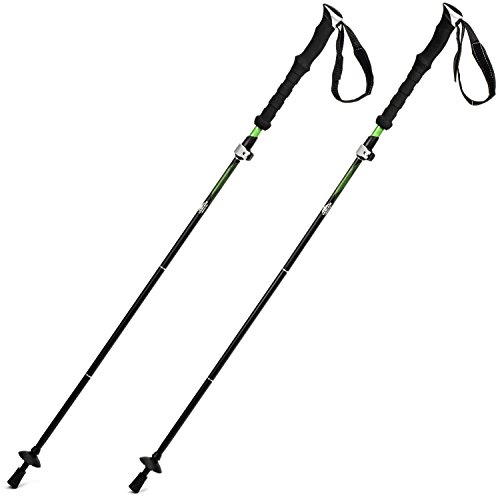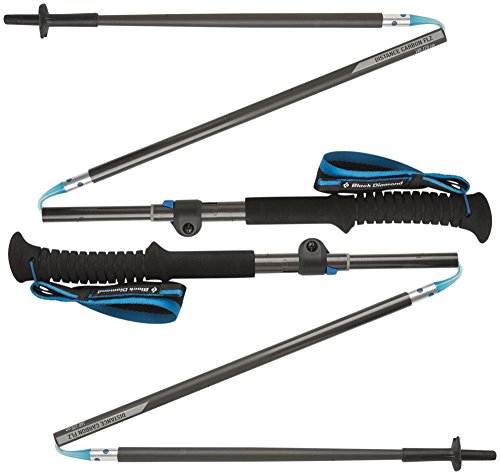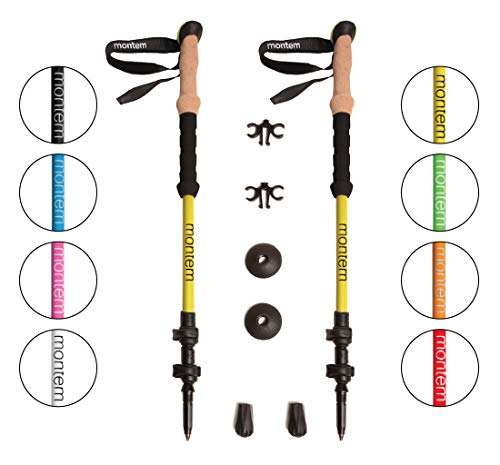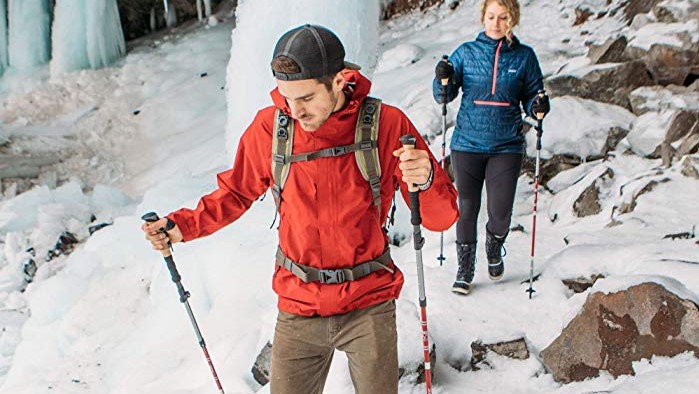
UPDATED: DECEMBER 2019
Trekking poles have been proven time and again to take stress off the joints and help to alleviate some of the stresses caused by high-intensity hiking. It’s also easy to see that using trekking poles in many situations can help to aid in balance, stride, and speed.
More...
When I first started using trekking poles, I wasn’t sure if they would be the right fit for me. Will they be too heavy? Will I use them often enough? What will I do with them when I’m not using them? Now, years later, I’ve used and recommended many trekking poles to fellow hikers and I can say for certain that they’re a valuable asset in any hiker’s arsenal of tools.
Like most hiking gear, however, trekking poles can range from inexpensive and heavy budget poles to ultralight futuristic poles that can disassemble. For many hikers, expensive and advanced hiking poles just aren’t necessary so today we’ll focus on budget trekking poles for those looking to save some cash.
For a detailed list of other low-cost (but not 'cheap') backpacking supplies, check our our massive guide to budget backpacking gear.
Comparison Chart
Name | Price | Weight | Rating | Notes |
|---|---|---|---|---|
$$$ | 1.96 lbs | Strong 7075 Aluminum with Cork Grip Extra EVA Foam-2 Pack | ||
$$$ | 1.5 lbs | Trekking Poles are made from light weight, durable aluminum. | ||
$$$ | 1.21 lbs | Lifetime Warranty | ||
$$$ | 1.4 lbs | 100% Carbon Fiber | ||
$$$ | 1.8 lbs | Actual weights may differ according to reviews | ||
$$$ | 1 lb | 100% carbon fiber construction, Lightweight, EVA foam grip with breathable, moisture-wicking grip | ||
$$$ | 1.3 lbs | Montem promises to replace your poles for life. | ||
$$$ | 1.6 lbs | Made of 7075 aviation grade aluminum, which is much more durable than carbon fiber materials. The EVA foam Grip is soft and anti-slip. | ||
$$$ | 1.6 lbs | 7075 aluminum alloy material pole body; Ergonomic Soft Cork Handle with wrist strap |
How to Choose Trekking Poles
Adjustable or Fixed Length
Many hikers prefer to choose a trekking pole with adjustable length. Adjustable trekking poles come in several varieties but they all achieve the same goal. Their goal is to be able to expand and contract to fit the height of each individual hiker. On top of that, you can adjust the poles to different lengths depending on whether your hiking, snowshoeing, or other various sports. This is a common feature but beware: adjustable hiking poles can be heavy! Weight added by the adjustable features can add up and create an overall heavy trekking pole.
Weight
Since you have to carry your trekking poles, either in your hands or on your pack, every ounce really does add up. Trekking poles and footwear are two of the biggest problem areas when it comes to weight. Think about it: weight carried on your back, once in motion, stays in motion. Any weight carried on your hands or feet must be swung back and forth with each step. Because your hands and feet stop and start much more often in comparison to your torso, any weight carried here requires significantly more energy.
Type of Adjustment
There are three main types of adjustable poles. Flick-lock, twist-lock, and pull-lock.Flick lock poles operate by using a small lever on each adjustable segment. This lever is opened or closed to fix the pole length in place. These poles can be adjusted to just about any length. Twist lock poles operate by twisting sections of the pole against one another to lock each segment. This allows the poles to be infinitely adjustable between a minimum and maximum range. Finally, pull lock poles are operated by pulling the handle segment of the pole. This tightens an internal cable which locks each segment into place. While these poles can be collapsed, they’re not necessarily adjustable. Once locked in place, they’re locked to a single predetermined length.
Shock Absorbing
For some reason, there seems to be a trend among adjustable trekking poles to include shock absorbing springs. Why? I have no idea.I’ve used both shock absorbing and solid poles (non-absorbing) and can say conclusively that I’ve never found a reason to have a shock absorbing pole. I don’t make a habit of violently stabbing my poles into the ground with enough gusto to generate a shock. Maybe if I was a much angrier hiker?The shock absorbing springs and mechanism in the pole also seems to add an exponential amount of weight to the overall construction as well.
Hiking Pole Prices
Prices can range from $20 for a cheap pair of hiking poles all the way up to $200.
By far the biggest factor that determines pole pricing is pole material. Aluminum poles are usually quite affordable compared to carbon fiber.
Just keep in mind that a good pair of aluminum poles might be $100 while carbon fiber poles may cost $170 or more for just a few ounces of weight savings.
Before deciding how much you should pay for poles, first decide which material you prefer and exactly how lightweight you want to go. If you want the bleeding edge of lightweight poles, you’ll be paying through your nose for that weight savings.
Putting it All Together
It’s hard to really get a “grip” on hiking poles without some visuals. So, in the spirit of getting you ready to hit the trail with the right hiking poles for you, check out this hiking pole overview video from Snowys Outdoors. It covers all the topics we’ve talked about here and gives you some perspective!
Do You Really Need Hiking Poles?
Until the last couple of decades, hikers didn’t use “trekking poles” as we know them today. Sure, the hiking stick was probably always a thing in one way or another – find a straight stick and carry it as a walking pole.
However, today’s modern style trekking poles have only really gained widespread popularity in the last 20 years or so.
Of course, whether or not you need hiking poles is probably entirely subjective to each person. However, here are some things to consider when making your own choice.
Hiking poles can help substantially with balance.
Whether crossing a slippery log or losing your balance walking the green tunnel, having poles at the ready can help stabilize your every step. Roll your ankle? Make a wrong step? You can quickly recover and take the weight off that foot by adjusting using your poles.
Hiking poles take the stress off your lower joints.
Various studies and experts are on the record citing statistics that I won’t bore you with (read this article by Backpacker about the details and studies). Suffice it to say that by using hiking poles you can take a lot of the stress and repeated pounding off of your knee and ankle joints.
Hiking poles can be used to assemble ultralight shelters.
Many ultralight backpacking shelters including these awesome tents from Light Heart Gear trade tent poles for hiking poles. This is a great example of the efficient use of items to reduce overall carried weight and bulk.
Given that studies show hiking poles remove upwards of 4% of the shock, impact, and stress from legs during hiking I think we can all find a place for them in our hiking routines. Sure, many of us are young now, but if we all want to still be out hiking in our waning years I’m sure each of us will be thankful for any extra longevity we can give our legs!
As a counterpoint, however, I know many colleagues and friends who don’t use or don’t like hiking poles. On top of personal preference, there is a case to be made for their environmental impact.
Are Hiking Poles Hurting the Trails?
In some areas, dozens, if not hundreds, of hikers walk the same trail each week. Heck, thousands pass certain points of many popular trails in a single month!
Each hiker has two feet and most have two hiking poles. Each step hikers plant their poles, push off, and repeat. Those poles have sharp carbide-tipped points that dig in and provide traction each time they’re planted on grass, stone, or earth.
Next time you’re on a popular trail I’d encourage you to look to the side of the trail. There, about 4 inches from the side of the trail on either side, you’ll start to notice little holes. If it’s a really popular trail you may even see two little parallel tracks or trails next to the main trail. These are the result of hundreds and thousands of hiking pole tips stabbing and unsettling the earth where they’re planted.
One solution available is rubber tips for hiking poles. Many hiking poles come with rubber tips that go over the carbide tips which are more harmful. However, those rubber tips aren’t nearly as sturdy and stable on most surfaces and somewhat reduce the effectiveness of the hiking pole’s ability to grip.
Note: Rubber tips are a must-have for sensitive ecosystems (or no poles at all), concrete, and extended rock surface areas.
At the end of the day, it’s up to you to make the decision on if and how to use hiking poles. Certain areas with particularly sensitive ecosystems may have total bans on the use of trekking poles so please check with your local ranger station before setting out.
How to Adjust Your Hiking Poles
Determining and setting the height
There are several ways to decide on a length for your hiking poles. For flat and moderate terrain I like to use the “90-degree” method. With your elbows bent at a 90-degree angle, set your poles so that the length matches the height of your hands to the ground. When holding your poles at rest your elbows should be bent at a 90-degree angle. This method has always worked well for me.
Of course, body mechanics is a complex topic and I’m far from an expert in physiology. So I encourage you to check out this helpful video on adjusting hiking poles from New Dimension Physical Therapy (note: video demonstrator uses the straps incorrectly but the rest of the video is worth paying attention to).
Best Budget Trekking Poles
This 4-section trekking pole is a pull-lock, flick-lock combo. Assemble the pole with the pull-lock mechanism and then adjust the overall length with the flick-lock handle segment.I like segmented poles because they can be packed down into very small packages. This is great for airline travel or car/bus travel to and from your destination. Definitely a budget trekking pole for bus and airline travelers to heavily consider.
What’s crazy about these poles is that each pole comes with its own lightweight packable sleeve. These are nice because you can protect the stuff in your backpack from the poles when you pack them down to travel in the car, bus, or plane. Overall there’s a lot of good value here.
This set of poles comes in at a shockingly low overall price. Adjustable from 26″ to 53″ with ribbed grips and adjustable secondary grips, these poles can cover just about any range of needs.When hiking up or down steep inclines it can be nice to just use the secondary grip rather than adjusting the overall pole length. Like many poles offered in this category, these poles have optional screw-on baskets and rubber tips.Supported by a 1-year manufacturer warranty, you’ll be able to take advantage of any of the standard features of modern adjustable poles. Three piece construction, anti-shock internals, and a host of budget-minded options.
Carbon fiber is one of the lightest and strongest materials available for making hiking poles today. That’s why carbon fiber poles tend to be expensive. Fortunately, working with carbon fiber is becoming easier and manufacturers are able to deliver quality trekking poles at a low price.These are three-piece pull-lock trekking poles with an adjustable flick-lock handle which pack down to an overall 15″ when disassembled. They’re lighter than the Himal poles we reviewed earlier, and feature all the same specs but they’re much lighter weight! While you’ll pay a bit more for them, I think they’re a solid winner for the budget trekking pole category.
This set of carbon fiber budget poles comes with so many accessories you’ll be hard-pressed to find a better buy! You’ll get mud baskets, snow baskets, rounded rubber feet, and standard rubber feet. These are a good upgrade choice if you’re looking for something lighter than the Himal Folding Trekking Poles we reviewed earlier.All of this with a three-piece flick-lock adjustable carbon fiber pole. They’ve put cork handles which are comfortable, absorb sweat, and contour to your grip. There’s also a soft foam secondary grip which can be adjusted much like the BAFX poles. These are a great pick for those looking to find a balance between price, weight, and function!
These 4-piece aluminum poles aren’t the lightest pick, but they offer tons of features and accessories. Get the compact features of a pull-lock pole with the height adjustment of a flick-lock pole while you enjoy a dual-height handle. One of my favorite features about these poles are the dual height handles with soft foam grips. I personally use a very similar pair of trekking poles.Like the Hiker Hunger poles, these come with two types of baskets and two types of rubber hiking tips to cover the carbide tips. One nice feature is the added travel bag that will help keep your trekking poles protected and organized when traveling by car, train, or plane.
Now we’re taking things up a notch as we look at the Black Diamond Carbon FLZ poles. BD is a company that has been making gear people literally depend on for life and limb. These carbon tri-fold flick lock poles are similar to many others out there, but the quality and customer service is next-level.
Because they’re carbon fiber they’re going to be among the lightest in-class for performance. If you’re the person who prefers top class quality and reliability and you don’t mind spending a bit more cash, then this is the last stop for you.
By far the biggest drawback here is that you’re going to spend top dollar.
Going a bit in the opposite direction, I feel the Montem ultra-strong poles give users a near-indestructible hiking pole to work with. Not everyone wants a lightweight pole, some of us know we’re hard on our equipment.
Not only are these poles made out of extra-thick 7075 aluminum, but you can also get them in 9 different colors.
Grips are made from cork which can help conform to your hand shape over time yet the secondary grip is EVA foam. Personally, I have come to like EVA foam as much or more than cork for grips. Fortunately, even if you wear out the grips, you can get them replaced for life thanks to Montem’s lifetime replacement promise.
It seems that when we start down the road of inexpensive hiking poles, the options become nearly limitless. These Glymnis poles are worth consideration, however, because they’re an adjustable flick-lock and collapsible 3-piece combo. While they’re not lightweight, they’re also not expensive. This makes them a great choice for the occasional user or weekend warrior. Why pay top dollar when you know you won’t be using them all the time? Exactly. All that said, if Glymnis delivers on their advertised weight of 9.5 ounces per pole it certainly makes these poles one of the best weight-value combinations on our list!
At over 12 ounces per hiking pole we’re not setting any records for ultralight thru-hiking here. Instead, what we’ve got is an incredibly affordable and versatile hiking pole that is absolutely loaded with features. this is another 3-section flick lock pole (my favorite for adjustability and packability). This time, however, the pole handles are ribbed cork and EVA foam with a double-grip. Without having to adjust the pole length, you can easily and comfortably choke up to a shorter pole length when ascending steep terrain. Switch back again just as easily. No awards for reinventing the wheel here, but this one does get an award for packing in great features at a rock bottom price point.
Conclusion
Now, there are many types of hiking poles but, for this article, we’ve chosen to focus on budget trekking poles. These poles are feature rich, lightweight, and inexpensive. They’re the perfect balance for beginner hikers or those looking to trim the price off of their next piece of gear.If you’re looking for the lightest weight budget options, I recommend seeking a carbon fiber pole with all the options you need at a low price. Hiker Hunger’s trekking poles we reviewed fit this bill nicely! For those looking to get the absolute cheapest trekking poles, it’s hard to argue with the BAFX poles.




